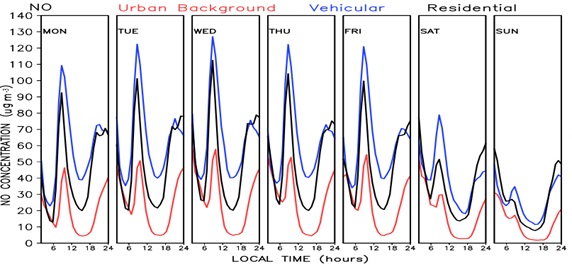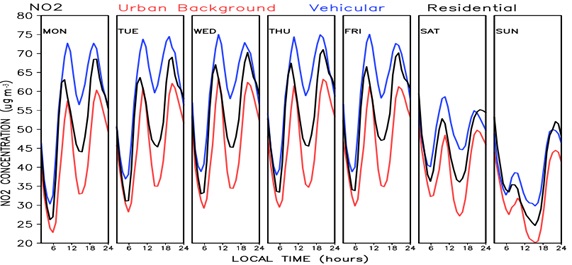1. Introduction
Megacities are generally defined as metropolitan areas with populations of at least 5 million inhabitants and have been the subject of intensifying scientific study as harbingers of increasingly complex coupled human-natural systems (LIU et al., 2007). Such systems are usually built of interdependent components characterized bynon-linear complex feedback mechanisms, particularly when the object of study presents high spatial variability, as analysed, for example, in the concept of geosystemsby Christofoletti (1999) and in the Brazilian geographic climatology (BARROS; ZAVATTINI, 2009). They tend to occur disproportionately in the Global South, where 9 out of the 10 largest world’s megacities are located (UN, 2014). By 2025, with the fast urbanization rate of the Global South, it is expected that about 14 urban areas worldwide (nine of them in Asia and two in Latin America) will become megacities (BAKLANOV et al., 2016). Environmental issues,along with other population-derived pressures,are among the most important components of these systems, since one affects the other and vice-versa (MENDONÇA, 2004). Among said cross-cutting fluxes, the urban climate and the contamination of air ranks among the main concerns (KRASS; MERTINS, 2014), as it is strongly impacted by human activities but impacts human health and well-being as well.In Latin America,the historically non-democratic urban and environmental planning (affecting land use, transportation, technologies, etc.) coupled with socio-economic problems (impaired quality of life, concentration of wealth, etc.) has led to concerning air pollution episodes and exposure through the recent decades, with severe health effects (AMANN, 2008; GURJAR et al., 2010).
The Sao Paulo Metropolitan Area (SPMA), the largest megacity of the Southern Hemisphere, is an example of such system, continually evolving and expanding. Currently with more than 20 million inhabitants, it has experienced population growth on the order of 12% since the beginning of the year 2000, most of it taking place in the outskirts where the lower-income population resides (SILVA; FONSECA, 2013).There are currently more than seven million vehicles in the SPMA. It is located 750-820 m above sea level, surrounded by hills and mountain ranges of up to 1200m, which constitute natural barriers for airflow, potentially trapping atmospheric pollutants, a condition which clearly demonstrates the interplay between man-made and natural systems.
Concerning air pollutants, it is estimated that 96% of carbon monoxide (CO),
67% of nitrogen oxides (NOx) and 40% of particulate matter with aerodynamic
diameter of 10 micrometres or less (PM10) are emitted by traffic (CETESB, 2016). While some pollutants such as CO and NO2 show a tendency of
decrease due to emission controls from governmental programs (MARTINS et al., 2004; ROZANTE et al., 2017), other pollutants such as PM2.5 and tropospheric ozone (O3)
often exceed the air quality standards, with 14and 43 exceedances of the daily
air-quality standards in 2014, respectively (CHIQUETTO et al.,
2019). For ozone, formed in the lower atmosphere from
the reactions between sunlight and NO2 with Volatile Organic
Compounds (VOCs),the attention level (200 µgm-3 for an 8-hour period)
was reached in five days in 2015 (CETESB, 2016). Increasing O3 trends are found in other megacities of the
Global South, such as Beijing (WANG et al., 2012), and linked to increases in population, emissions, and also regional
transport. The atmosphere of the SPMA is also highly contaminated by VOCs,
emitted both by diesel (more reactive species) and ethanol-fuelled vehicles,
common in Brazil (ANDERSON, 2009; TSAO et al., 2011; ALVIM et al., 2016). These pollutants oxidize NO to NO2 in a series of
reactions, which contribute for an increase not only in NO2concentration, but also, in more ozone. Ozone is a particularly complex
gas in a megacity setting because it can be not only formed, but also consumed
by NOx and VOCs, according to their concentration, ratio, atmospheric stability
and other factors (BRASSEUR et al., 1999; SEINFELD; PANDIS, 2016).
Robust research has been done in this region on the health impacts of atmospheric pollution (GONÇALVES et al., 2005; BRAVO et al., 2016), as well as on the meteorological and chemical characteristics and interactions of air pollution (FREITAS et al., 2007; ALVIM et al., 2016). But not as much research has been done on the intraurban differences of air pollution, particularly concerning land use variations and changes in this complex urban area (CHIQUETTO et al., 2017). Different kinds of urban land use and land cover, which vary significantly in the intra-urban scale,produce different surface and emission conditions within megacities (CHAMEIDES et al., 1992), and are associated to different exposure situations (location of sources, distance from monitoring points)within large urban areas (JOHNSON et al., 2010; WHO, 1999; WHO, 2000). Therefore, knowledge of the characteristics and patterns of emission are of vital importance to understand pollutants concentrations (YUVAL; BRODAY, 2006; LEVY et al., 2014).
Worldwide, many previous air pollution investigations in the intra-urban scale have assessed both atmospheric variables and urban land use/emission characteristics.The importance of conjugating these data in an integrated and interdisciplinary approach is a common understanding (MOLINA; MOLINA, 2004; WENG; YANG, 2006; PUJADES-RODRIGUEZ et al., 2009; SZPIRO et al., 2010; AMORIM, 2011; KRAAS; MERTINS, 2014; LEVY et al., 2014). In the context of the SPMA, the lack of planning and loss of administrative municipal power concerning urban land use change potentially aggravates air pollution problems (such as heavy traffic congestion episodes), in spite of recent local governance efforts such as the Strategic Directive Plan for the city of São Paulo (Plano Diretor Estratégico – SÃO PAULO, 2014). Among the guidelines of this plan is the implementation of cycleways and pedestrian precincts, but in areas surrounded by heavy vehicular activity.
In view of the pressing issues concerning fossil fuel use and its non-renewability, it is reasonable to assume that the use of ethanol (or other plant-based fuels) might increase in the next decades, such as Brazil which has been paving the way since the last decades(particularly in places where there is intensefuel demand). Therefore, current air pollution problems encountered in the greater SPMA might be harbingers of the issues many megacities (currently still not as large or economically relevant as the SPMA) would face in the future. Long-term studies across different sites, such as the one presented here, are vital to improve the knowledge of how to generalize case studies from one place to another (LIU et al., 2007).Besides, changes in the city design are expected from the Strategic Directive Plan, such as the building of parks, pedestrian precincts and cycleways, which have also beenan increasing tendency in many cities in the developed world.Such changes will possibly increase population flux in different areas within the megacity in the following 15 years or so, which will translate into different exposures to atmospheric pollutants.
This paper presents the results of an analysis of sixteen years of hourly air quality monitoring observations at four different sites located in the SPMA and how air quality varies as a function of different land use (as per World Health Organization suggested criteria). Results are presented and interpreted in terms of human-influencedand natural-influenced factors, in an attempt to qualitatively and quantitatively analyse how much each of these systems (natural and anthropogenic) impacts pollutant concentrations in a megacity in the Global South across a range of time scales from daily to annual. Results should provide useful information for policy makers in megacities as to what expect in terms of temporal and spatial distribution of air pollution and exposure, particularly for developing countries. Such knowledge is vital in order to support the design and implementation of air pollution management actions and plans for short and long-term air quality strategies and standards.
2. Data and Methodology
CO, PM10, NO, NO2, and O3 data from the
monitoring network ofthe Environmental Agency of the State of São Paulo (CETESB)
were used in this study. Four sampling sites where chosen in the SPMA, in order
to characterize atmospheric pollution in different land use/emission
conditions, following WHO classification criteria on urban land use and
exposure conditions (WHO, 2000). They were classified as vehicular, commercial, residential and urban
background (U-BG) by CETESB, representing different conditions within the
megacity. Their location is presented in Fig. 1 along with the location of the
SPMA.
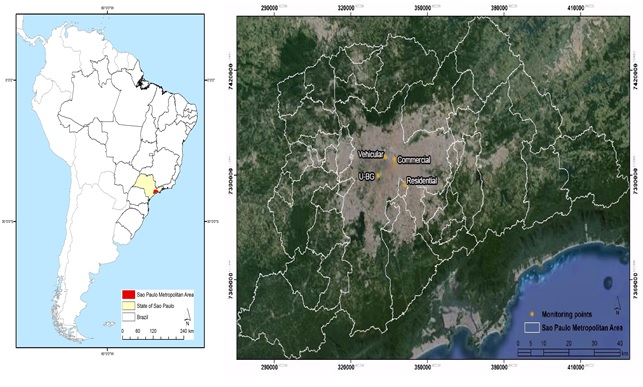 Figure 1
Location of the SPMA (left)
Figure 1
Location of the SPMA (left)
Location of the SPMA (left); satellite image and political
boundaries of the SPMA with the location of CETESB air quality monitoring
stations used (left)
Source: Satellite image and political
boundaries of the SPMA with the location of CETESB.
In this study, we used data from 1996-2011, for all pollutants, except for the commercial site, which has only PM10 and O3 data starting from 1997. We chose not to further extend our time series because we are relating air pollution to the land use characteristics in the immediate vicinity of the monitoring stations. Because intraurban land use changes in these scales are more likely to be observed over longer periods of time, if we extended the time series, we would also have to assess the land use changes through the same time period around each monitoring point, which would make this study longer and change its scope.
Pollutants weremeasuredhourly using referenced scientific methods – beta radiation for PM10, chemiluminescence for NOx, non-dispersive infrared for CO and ultraviolet radiation for O3. Data is available freely online by CETESB after a quick subscription in the system at http://qualar.cetesb.sp.gov.br/qualar/home.do . For the larger scale analysis, outgoing longwave radiation (OLR) and surface atmospheric pressure were obtained at Reanalysis 2 (KANAMITSU et al., 2002) for an area representative of the east of the São Paulo state, for which a spatial average was calculated.
The World Health Organization states that decision makers should address different types of urban land use and locations when implementing an air quality network in a given area, in order to gather information about how population is potentially exposed to air pollution inside the city and in its suburbs and also due to the different spatial representativeness of different monitoring sites (WHO, 1999; WHO, 2000; MARTIN et al., 2014). Table 01 shows the four urban land use classes used in this study, which were classified by CETESB following abovementioned criteria, along with the identification of the main traffic roads and vehicle traffic in a 300-m radius around the monitoring points, using the aforementioned documents and data provided by the state Traffic Engineering Company (CET), in a description scheme somewhat similar to the ones used in Briggs et al. (2000) and Vardoulakis et al. (2005). Aerial images showing the different characteristics of each site are shown in Fig. 2.
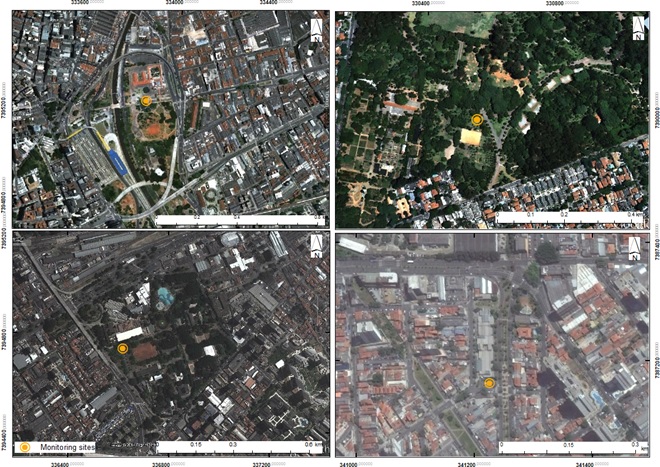 Figure 2
Aerial
images of the vehicular
Figure 2
Aerial
images of the vehicular
Aerial
images of the vehicular (top left), U-BG (top right), commercial (bottom left)
and residential (bottom right) sites, showing their different characteristics.
The monitoring points are indicated by the orange circles
Table 1
Land use classes as suggested by the WHO and characteristics of each site monitored

*According to the Traffic Engineering Company.
**Also included total daily trips from the nearby bus terminal.
Diurnal and weekly
cycles were calculated by averaging the same hour of the day of the week, in an
attempt to capture thehourly variations during the different days of the week
for each pollutant in each monitoring point. It was assumed that, in this small
scale, the influence of land use would be much stronger than in the other
temporal scales. We also performed Pearson’s correlation between the weekly cycles
of PM10 and CO, and PM10 and NO2,which could provide
an insight about particulate pollution sources.
For the seasonal analysis, we calculated one single seasonal average for each pollutant at each site by averaging concentrations of three months representative for each season in the Southern Hemisphere: DJF –summer, MAM –autumn, JJA –winter and SON –spring.In order to assess atmospheric seasonality influence over pollutant concentrations, we compared the highest and lowest seasonal average concentrations in the same site and observed this difference in percentage (keepingthe site, varyingthe seasons). In order to assess the urban land useimpact over pollutants, we compared the highest and lowest average concentrations across the different monitoring siteswith different urban land use classes, but in the same season, also in percentage (keepingthe seasons, varyingthe sites). Since atmospheric conditions, in the seasonal scale,are somewhat similar in the metropolitan area, it was assumed that the difference in concentrations were mainly due to atmospheric chemistry changes, induced locally by the exposure/emission/land use characteristics.
Finally, monthly average concentrations of the chosen pollutants were calculated, resulting in monthly time series for the studied period, for comparison with spatially-averaged monthly OLR at 200 mb and surface pressure data for an area encompassing 24.5◦ to 22.5◦ S and 45◦ to 47◦ W, (east of the Sao Paulo state). Pearson’s correlation coefficients were obtained between OLR and the pollutant monthly averages in each site, in order to analyse if the influence of regional atmospheric systems (which bring cloudiness and atmospheric instability in this region) for the selected pollutants was different at each monitoring point, in a larger temporal scale, according to the land use classes. OLR is an indication of vertical motion and instability in the atmosphere, and as such, could influence pollutant dispersion conditions. A quality control was implemented following the methodology described in Chiquetto and Silva, (2010). For monthly averages, at least 20 days of valid data were necessary, otherwise the month was flagged as invalid, and for the daily averages, if more than 8 hours of the day were invalid, the whole day was flagged as invalid.
3.
Results and Discussion
3.1. Weekly and Diurnal cycles
The 16-year diurnal and weekly cycles
of the criteria pollutants is shown in figure 3. There are clear differences in
the hourly behaviour among the different pollutants analysedaccording to their
land use types
 Figure 3
Weekly cycle of hourly CO (top), PM10,
NO, NO2 and O3 (bottom), for the assigned monitoring
points (commercial in green, U-BG in red, vehicular in blue, residential in
black)
Figure 3
Weekly cycle of hourly CO (top), PM10,
NO, NO2 and O3 (bottom), for the assigned monitoring
points (commercial in green, U-BG in red, vehicular in blue, residential in
black)
The weekly/diurnal cycle of CO shows higher concentrations and longer peaks in the residential site (around 1.9 ppm), probably due to the predominance of light-duty vehicles activity by the population living in the area, characterized by high income levels, and so, the availability of individual transportation. This makes sense because light-duty vehicles emit much more CO than heavy-duty vehicles. Meanwhile, the vehicular site is more affected by heavy-duty vehicles (Table 1). CO peaks occur twice a day, following the morning and evening rush hour times, as has been observed by other studies (WENG; YANG, 2006) and also in thisstudy area (ROZANTE et al., 2017; CHIQUETTO et al., 2017). In the U-BG site, concentrations are lower (peaking at 1.3 ppm) and there’s a lag of one hour – probably because of advection time, due to the longer distance of the pollution sources. During the afternoon, concentrations decrease due to greater turbulence in the boundary layer from solar heating combined with a decrease in emissions compared to the rush hours. Likewise, concentrations increase after midnight and during early morning hours, probably associated to a lower boundary layer during these hours, after the evening rush hour. On weekends, concentrations decrease substantially (particularly on Sundays), but remain higher in the residential site (indicating substantial urban activity). Also, the peaks occur at night, during hours when people often return or leave home during weekends.
For the particulate pollution,
patterns are very different temporally and in each monitoring site, but
generally presenting three peaks during the weekdays. Two of these peaks are
associated to the morning and evening rush hours are also present, when
concentrations are higher in the vehicular site (around 60 µgm-3),
but there are many other sources and factors other than vehicle activity which
influence particulate pollution (GIUGLIANO
et al., 2005; KULSHRESTHA
et al., 2009). In the U-BG site, located inside an
urban park, the evening peak is much higher (around 50-55 µgm-3)
than the morning peak, while in the residential and commercial sites, peak
concentrations in the morning and evening are generally similar (around 40-50 µgm-3).
For all sites, the midnight/early morning peak is higher than other peaks (60 µgm-3),
probably due to the low boundary layer, except for the U-BG site, where the
evening peak is still higher. Also, concerning this site, higher PM10
concentrations are observed during weekends, much higher than in other sites,
patterns which are probably associated to the public leisure activities in the
park (with more than 200.000 visitors every weekend), which has many bare soil
surface areas close to the monitoring point. It may also be the cause of the
higher concentrations in the evenings – when people leave work or school and
play sports or simply walk and enjoy the park at night. The commercial site,
located in an area with mixed land use characteristics inside a school (with
bare soil surfaces for sports practices – Fig. 2), also presents higher PM10
concentrations during weekends compared to the vehicular and residential sites.
Correlation coefficients between the average diurnal cycles of PM10
and CO are of 0.43 for the vehicular site, 0.47 for the residential site and
0.01 for the U-BG site, suggesting that an important part of the particulate
pollution could be associated to light vehicle traffic in the first two sites,
especially the residential site. Correlations coefficients between PM10
and NO2, are of 0.26 for the vehicular site, 0.21 for the
residential site and 0.18 for the U-BG site, suggesting that the source of
particulate pollution can be associated to heavy vehicle traffic in the first
two sites, particularly in the vehicular site. Scatterplots are shown in Fig.
04.
 Figure 4
Scatterplots of the correlations between the average weekly cycles of CO and PM10 (left) and NO2 and PM10 (right) for the U-BG, residential and vehicular sites.
Figure 4
Scatterplots of the correlations between the average weekly cycles of CO and PM10 (left) and NO2 and PM10 (right) for the U-BG, residential and vehicular sites.
For NOx, the weekly/diurnal cycle clearly
also shows the peak hours associated to the morning and evening rush hours,
with higher values of NO (NO2) at nearly 130 (75) µgm-3
at the vehicular site, which is under intense influence of heavy-duty vehicles
emissions (Table 1) due to the proximity to many avenues with intense traffic of
vehicles, the São Paulo city market and an important bus terminal, which is
used by an average of 196.000 people/day, with 61 bus lines, 961 vehicles and
590.000 bus trips/day (CET,
2014 and communication with the City
Transport Company). At the U-BG site, NO (NO2) peaks occur at 50
(60 )µgm-3,
and also later in the day. The residential site shows intermediate
concentration levels. It is known that NO2 has both primary and
secondary origins. When emitted by vehicle exhaust, it is actually formed
inside vehicle engine via the reaction between NO and oxygen at high
temperatures. When formed in the atmosphere, it is via the reaction between NO
and O3 or the oxidation of NO to NO2 via VOCs (BRASSEUR et al., 1999). The morning NO2 peaks
occur later than the NO peaks in all monitoring sites, evidencing the chemical
transformation from NO to NO2. Also, NO2 concentrations
vary less through the day compared to NO and the evening peak is of similar
magnitude of the morning peak (unlike NO which shows a much higher morning
peak); also, NO2 concentrations are higher in the U-BG site compared
to NO. These results suggest that the secondary parcel of NO2might be
more important than the primarily emitted across the megacity (PANDEY
et al., 2008; LEVY et al., 2014). During weekends, concentrations of
both pollutants decrease significantly in all monitoring sites.
For the ozone averages, there is much
less variation throughout the day across the sites. The weekly/diurnal cycle
shows peak concentrations (about 90 µgm-3 in the U-BG site) in the middle of
the afternoon on all days, when solar radiation income is maximum and there is
availability of precursors emitted in the morning rush hour, as observed in many
other locations (BEIG et
al., 2007; TANG et al., 2012). There is also an early morning increaseof
O3 at about 4 AM local time in all sites, probably associated to the
low boundary layer and greater atmospheric stability in these hours, as
observed with other pollutants. Higher concentrations occur in the residential
and U-BG sites during the whole week; they are lower in the commercial site and
even lower the vehicular site, which is under direct influence of heavy-duty
vehicles and has greater NOx concentration, which might end
up acting as a sink of O3. This findings suggests that the
removal of O3 through titration has an important role when defining
ozone concentrations locally (GENG et al., 2008), which can be associated to the type
and total amount of vehicles in each location (Table 1). The residential site
shows highest concentrations at night than other sites. The commercial site,
located in an area with mixed land use and intermediate distance to the roads,
also shows intermediate O3 concentration levels. On weekends,
concentrations are higher, showing the “weekend effect” which has also been
observed in other studies (QIN,
2004; SILVA JÚNIOR et al., 2009; LEVY et al., 2014). The slight
increase in ozone at about 4 am is present in all sites and we theorize it
could be a likely result from the decrease in the boundary layer height.
Analysis of the hourly standard deviations (data nor shown) indicates that, for all pollutants, temporal variability is higher during the times of maximum diurnal concentration (morning and night for primary pollutants, mid-afternoon for ozone, etc.). This implies that emission conditions also play an important role in the long-term diurnal variability of pollutants. T-student tests were applied to test the difference between pollutant concentrations in the weekly scale in different sites(ex: PM10 at the residential site vs. PM10 at the commercial site, and so on) was found significant for the 99% interval for all tests, except for the difference betweenthe residential and vehicular sites for CO, (95%).
3.2.Seasonal Analysis
In the SPMA, most of the primary pollutants tend to have a distinct seasonal cycle with a minimum during summer (due to greater air instability and precipitation) and a maximum in the more stagnant and dry wintertime conditions (MASSAMBANI; ANDRADE, 1994; CETESB, 2016). For ozone, a minimum occurs from late-autumn to mid-winter, and a maximum in mid-spring, according to the solar radiation seasonal variations in the SPMA (MASSAMBANI; ANDRADE, 1994; CHIQUETTO; SILVA, 2010). Also, local increase of NO during winter could contribute to a greater ozone loss by titration.
Table 2 shows the comparison between the known effects of seasonality and investigated effects of land use in different pollutants. For NO and O3, the seasonal variation intensity can be compared to that induced by emission/land use characteristics. For NO2 and PM10, the seasonal variation is much stronger, particularly for the latter, while for CO, land use variations are stronger.
In the commercial site, CO measurements started in 2005, so data is not shown for comparison with other sites (according to other published works, there is a strong decrease in CO concentration in the study area since the last decade (RIBEIRO et al., 2016; ROZANTE et al., 2017), which could cause a bias in the study). CO concentration averages are higher in the residential site, even compared to the vehicular site. Albeit being a less reactive primary pollutant, some studies also show that CO can be impacted by local emission characteristics, showing marked differences in concentration in small spatial scales, of a few blocks (WENG; YANG, 2006). This could be associated to the fact that, in a residential area, the prevailing traffic is from light-duty vehicles (especially in high-income areas, where more people can afford purchasing cars, such as where this station is located), compared to the more heavy-duty-traffic characteristics of the vehicular site studied. This suggests that land use/emission characteristics play an important role in the seasonal scale, and the spatial variations of CO could be stronger than seasonal variations across the megacity. Statistically significant differences for CO were found in all sites investigated, except between the residential and vehicular sites.
Concerning PM10, seasonal differences in each site are much more intense than the land use/emission differences. This could be attributed to the diversity of particulate emission sources, both anthropogenic and natural, such as biomass burning, soil resuspension, marine salt, besides the secondary fraction of the PM formed in different environmental conditions (DE MIRANDA et al., 2012). This suggests that, in the interannual scale, seasonal differences can be much more relevant than spatial variations for this pollutant in this study area (GIUGLIANO et al., 2005; KULSHRESTHA et al., 2009), surely differently from what was observed in the diurnal/weekly scale (Fig. 1). In spite of these findings, statistically significant differences were found between all sites, except between the U-BG and residential sites.
Table 2
Comparison between the influences of land use
(bold, far right in each box) and seasonal variations (italic, bottom in each
box) in seasonal averages.
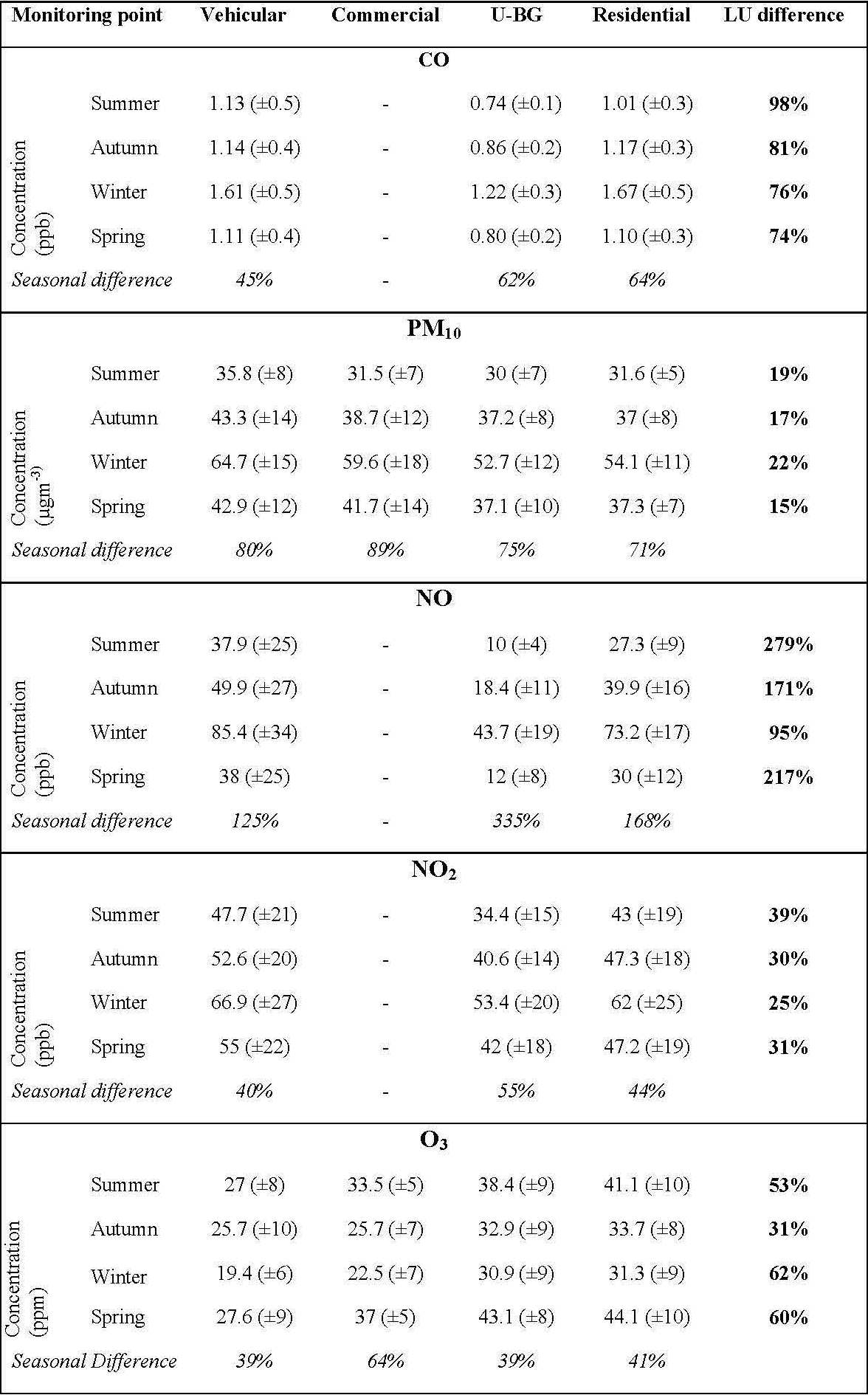
However, concerning NO, strong differences concerning both seasonal variation and land use/emission were observed, possibly due to the fact that it is a highly reactive gas. Pandey et al., (2008) observed concentrations 4 times higher in a rural background site compared to a vehicular site. In this study, the difference between the vehicular and the U-BG site is of 277% during summer (nearly thrice as high). As a primary pollutant, its concentrations are lower in the U-BG site, and higher in the other sites, particularly in the vehicular site. Statistically significant differences for NO were found in all sites investigated.
For NO2, which is less reactive than NO, seasonal differences are more intense than land use/emission differences(albeit less than for PM10).These results reinforce the idea that secondary NO2 is more relevant across the SPMA than direct NO2 vehicular emissions. Other regional processes, such as emission from agricultural areas, etc., could also influence seasonal variations of NO2, particularly at the U-BG site (where seasonal differences are about 55%); this could be further investigated with the use of atmospheric models (PANDEY et al., 2008). Statistically significant differences for NO2 were found in all sites investigated.
For ozone, in the vehicular, residential and U-BG sites, seasonal differences are approximately 40%. In the commercial site, which presents transitional land use/emission/exposure characteristics, the seasonal variation increases to 64%, showing greater temporal variation compared to other sites. On the other hand, land use/emission variations around each site also influence O3, with concentrations in the residential site 62% higher than the vehicular during the minimum in winter and 60% higher during the maximum in spring. As discussed previously by the literature (GENG et al., 2008; PANDEY et al., 2008; BIGI; HARRISON, 2010), higher O3 concentration averages are not observed in sites directly close to the emission sources, with higher urban activity, but in areas with lesser activity (residential) or further away from emissions (U-BG), especially when considering complex megacities. Statistically significant differences in ozone concentrations were found between all sites, except between U-BG and residential.Seasonal averages were also statistically tested in the same way as diurnal/weekly cycles and are significant for the 99% interval, except between the residential and U-BG sites for ozone, which are significant for the 95% interval.
3.3. Monthly means and correlation
with regional atmospheric data
Table 3 show the results between the correlations between OLR and the criteria pollutants. Figure 5 shows the strongest correlations (O3 and MP10). Results are stronger for the U-BG site than the vehicular site, which demonstrates that urban land use plays an important role even when definig the influence of regional atmosphereic systems over pollutant concentrations.
Positive correlationsbetweenregional monthly OLR with PM10 (0.22 to 0.37) in all monitoring sites (table 3) are probably due to the fact that cloudiness is commonly associated to atmospheric instability or low surface pressure in tropics (e.g. precipitation), conditions which tend to increase pollutant dispersion, and also due to its great diversity of sources and also for the environmental-dependent complexity involving secondary aerosol chemistry (LEVY et al., 2014). These correlations are much lower for the primary pollutants (around 0.1) and at the vehicular site (0.22), which are much more directly impacted by emissions, which also suggestthat emission and land use play important roles in pollutant concentrations when considering larger temporal and spatial scales. However, for ozone, stronger correlations with OLR (from 0.33 to 0.48) are probably associated to the fact that cloudiness conditions decrease solar radiation at the surface, and so, hinder photolysis that triggers ozone production (MASSAMBANI; ANDRADE, 1994; CHIQUETTO; SILVA, 2010).
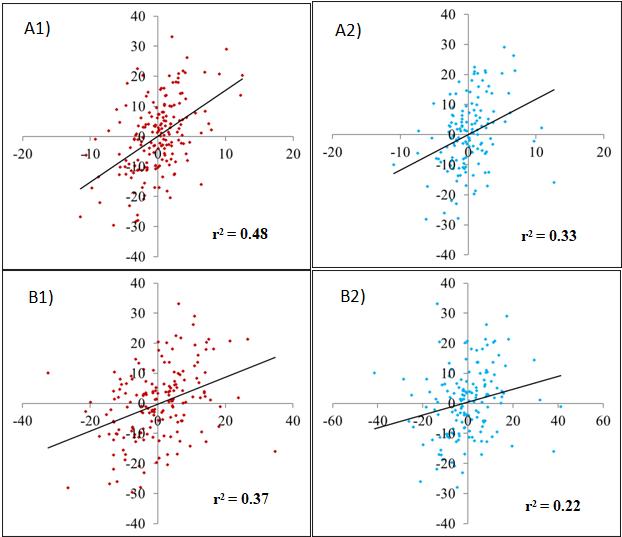 Figure 5
Scatterplots showing
monthly OLR and ozone correlations
Figure 5
Scatterplots showing
monthly OLR and ozone correlations
Scatterplots showing
monthly OLR and ozone correlations (A1: U-BG, A2: vehicular) and OLR and PM10
(B1 – U-BG and B2 – vehicular).
Table 3
Correlation coefficient
between monthly means of OLR at 200 mb, from 1996-2011, and the selected
pollutants in the different urban land use classes

*Statistically
significant correlation
Correlations
are stronger for all pollutants at the urban U-BG site,which shows more clearly
that regional-scale atmospheric conditions exert a stronger influence at the
U-BG site compared to other monitoring sites,especially comparing to the
vehicular site (Figure 5) (GENG et al., 2008; TANG et al., 2012; LEVY et al., 2014). The residential site shows stronger
correlations for ozone, similar to the U-BG site, but also lower for the
primary pollutants, similar to the vehicular site, since it is impacted locally
by CO emission (Fig. 2, Table 2). Moreover, for O3 and PM10,
correlations were statistically significant in all sites, showing that
conditions associated to atmospheric instability on a regional scale impact
more on secondary pollutants than on primary pollutants. At the U-BG site,
correlations were statistically significant with OLR for all pollutants,
including primary pollutants, demonstrating the importance of land use in the temporal
variability of pollutants in the intraurban scale.
4. Conclusions and Final Considerations
The objective of this
study was to demonstrate the influence of land use in air pollutant
concentrations in different land use types within the Sao Paulo megacity, in a
range of different time scales from hourly to long-term monthly, in the
perspective of complex coupled human-natural systems.Results show that the
characteristics of the location of the monitoring site, including distance from
pollutant sources (and sinks), density of roads, number of vehicles, surface
cover and overall predominant activities (represented by the urban land use
class), strongly impact pollutant concentrations and their spatial and temporal
variability in all scales of analysis. Urban land use influence is stronger in
the diurnal/weekly cycles, particularly for primary pollutants derived from fuel
combustion (CO and NO), with concentrations about two to three times higher in
the residential sitefor CO (accounting for individual auto use), or in the
vehicular site, for NO (heavy vehicle use), compared to the U-BG site. For NO2 and O3, the daily
amplitudes are less marked than the primary pollutants, showing that
concentrations are also influenced by environmental conditions associated to
transport and chemical reactions. This also suggests that the secondary
fraction of NO2 is relevant in all urban land use classes and might
be so across the megacity of São Paulo. For PM10, the patterns are
very diverseon the different days in each monitoring site, associated to its diversity
of sources, both human and anthropogenic.Land use strongly influences CO
variations in the seasonal scale. However, for O3 and NO, seasonal
differences are as strong as land use/emission differences, and for NO2
and PM10, seasonal differences are stronger in this scale of analysis,
especially for particulate pollution, suggesting the relevance of interannual atmospheric
or regional transport processes.In the longer time series and regional analysis,
all these differences are less marked, as expected. Nevertheless, they are still
presentand statistically significant.
These results demonstrate that, due to the complex mosaic of urban land uses within megacities, the spatial variability of air pollutants are considerably affected by 1) the predominant urban activities, 2) the pollutant considered and 3) the temporal scale of analysis.As one moves towards larger temporal and spatial scales of analysis, air pollution shiftsfrom an anthropogenic to a naturally-inducedsystem, yet the influence of land use is perceived somehow across all scales. This could help policy makers to better plan air quality abatement public policies, when, for example, aiming to attain air quality standards for each pollutant which also have regulations in different time scales (yearly, daily, etc.). It also suggests that the spatial variability ofpollutant concentrations can be complex in such environments, particularly for shorter time scales. Finally, these findings may have implications for future decision-making and environmental, public health and transportation policies for similar megacities involving land use change when considering air quality problems. For example, it is expected that ozone concentrations will increase in areas where city parks or other pedestrian-friendly structures are to be built if they are bordered by important roads with significant precursors emission, exposing the commuting or visiting population to higher ozone concentrationswithin megacities, especially should the fuel use shifts from gasoline to ethanol, demonstrating the complexity of interchanges between human and natural components within a megacity system.
5. References
ALVIM D.S.; GATTI L.V.; CORRÊA S.M.; CHIQUETTO J.B.; DE SOUZA ROSSATTI C.; PRETTO A.; DOS SANTOS M.H.; YAMAZAKI A.; ORLANDO J.P.; SANTOS G.M. Main ozone-forming VOCs in the city of Sao Paulo: observations, modelling and impacts. Air Quality, Atmosphere & Health. New York, v. 10, n.4, p. 421-435, 2016. https://doi.org/10.1007/s11869-016-0429-9
AMANN M.; DERWENT, D.; FORSBERG, B.; HÄNNINEN, O.; HURLEY, F.; KRZYZANOWSKI, M.; DE LEEUW, F.; LIU, S. J.; MANDIN, C.; SCHNEIDER, J.; SCHWARZE, P.; SIMPSON, D. Health risks of ozone from long-range transboundary air pollution. Copenhagen: World Health Organization Regional Office for Europe, 2008.
AMORIM, M. C. C. T. Climatologia e Gestão Do Espaço Urbano. Mercator. Fortaleza, v. 9, n.1, p.71-90, 2011. https://doi.org/10.4215/RM2010.0901.0005
ANDERSON, L. G. Ethanol fuel use in Brazil: air quality impacts. Energy & Environmental Science. London. v. 2, n. 10, p. 1015, 2009. https://doi.org/10.1039/b906057j
BAKLANOV, A.; MOLINA, L. T.; GAUSS, M. Megacities, air quality and climate. Atmospheric Environment. Amsterdam, n. 126, p. 235–249, 2016. https://doi.org/10.1016/j.atmosenv.2015.11.059
BARROS, J. R.; ZAVATTINI, J. A. Bases conceituais em climatologia geográfica (theconceptual bases in geographicalclimatology). Mercator. Fortaleza, v. 8, n. 16, p. 255-26, 2009. https://10.4215/RM2009.0816.0019
BEIG, G., GUNTHE, S., JADHAV, D. B. Simultaneous measurements of ozone and its precursors on a diurnal scale at a semi urban site in India. Journal of Atmospheric Chemistry. Amsterdam, v. 57, n. 3, p. 239–253, 2007. https://doi.org/10.1007/s10874-007-9068-8
BIGI, A.; HARRISON, R. M. Analysis of the air pollution climate at a central urban background site. Atmospheric Environment. Amsterdam, v. 44, n. 16, p. 2004–2012, 2010. https://doi.org/10.1016/j.atmosenv.2010.02.028
BRASSEUR, G., et al. Atmospheric chemistry and global change. Oxford, Oxford University Press, 1999.
BRAVO, M. A.; SON, J.; DE FREITAS, C. U.; GOUVEIA, N.; BELL, M. L. Air pollution and mortality in Sao Paulo, Brazil: Effects of multiple pollutants and analysis of susceptible populations. Journal of Exposure Science and Environmental Epidemiology. Berlin, v. 26, n. 2, p. 150–161, 2016. https://doi.org/10.1038/jes.2014.90
BRIGGS, D. J.; DE HOOGH, C.; GULLIVER, J.; WILLS, J.; ELLIOTT, P.; KINGHAM, S.; SMALLBONE, K. A regression-based method for mapping traffic-related air pollution: application and testing in four contrasting urban environments. Science of the Total Environment. Amsterdam, v. 253, n. 1–3, p. 151–167, 2000. https://doi.org/10.1016/S0048-9697(00)00429-0
CET – Companhia de Engenharia de Tráfego. Pesquisa de Fluidez –Desempenho do Sistema Viário Principal: Volume e Velocidade – 2013. São Paulo, Diretoria Adjunta de Planejamento, Projetos e Educação de Trânsito – DP, 2014.
CETESB – Companhia Ambiental do Estado de São Paulo. Relatório Anual da Qualidade do Ar do Estado de São Paulo, 2015. São Paulo: Divisão de Análise de dados, 2016.
CHAMEIDES, W. L.; FEHSENFELD, F.; RODGERS, M. O.; CARDELINO, C.; MARTINEZ, J.; PARRISH, D.; WANG, T. Ozone precursor relationships in the ambient atmosphere.Journal of Geophysical Research. Washington DC, v. 97(D5), p. 6037-6055, 1992. https://doi.org/10.1029/91JD03014
CHIQUETTO, J. B.; SILVA, M. E. S. Sao Paulo’s “Surface Ozone Layer” and the Atmosphere. Saarbrücken, VDM Verlag Dr Müller, 2010.
CHIQUETTO, J. B.; SILVA, M. E. S.; CABRAL-MIRANDA, W.; RIBEIRO, F. N. D.; IBARRA-ESPINOSA, S. A. ; YNOUE, R. Y. Air Quality Standards and Extreme Ozone Events in the São Paulo Megacity. Sustainability, v. 11, p. 3725, 2019. https://doi.org/10.1016/j.atmosenv.2017.03.051
CHIQUETTO, J. B.; YNOUE, R.; CABRAL-MIRANDA, W.; SILVA, M. E. Concentrações de ozônio troposférico na Região Metropolitana de São Paulo e a implementação de parques urbanos: observações e modelagem [Concentrations of Tropospheric Ozone in the Metropolitan Area of São Paulo and theimplementation of Urban Parks]. Boletim Paulista de Geografia. São Paulo, n. 95,p 1-24, Jan. 2017, SpecialIssue. Available online: https://agb.org.br/publicacoes/index.php/boletim-paulista/article/view/668. Accessed on: 20/03/2020.
CHRISTOFOLETTI, A.Modelagem de Sistemas Ambientais. Edgard Blücher, 1999.
DE MIRANDA, R. M.; DE FATIMA ANDRADE, M.; FORNARO, A.; ASTOLFO, R.; DE ANDRE, P. A.; SALDIVA, P. Urbanairpollution: a representativesurveyof PM2.5 massconcentrations in sixBraziliancities. Air Quality, Atmosphere & Health. New York, v. 5, n. 1, p. 63–77, 2012. https://doi.org/10.1007/s11869-010-0124-1
FREITAS, E. D.; ROZOFF, C. M.; COTTON, W. R.; DIAS, P. L. S. Interactions of an urban heat island and sea-breeze circulations during winter over the metropolitan area of São Paulo, Brazil. Boundary-Layer Meteorology, New York, v. 122, n. 1, p. 43–65, 2007. https://doi.org/10.1007/s10546-006-9091-3
GENG, F.; TIE, X.; XU, J.; ZHOU, G.; PENG, L.; GAO, W.; ZHAO, C. Characterizations of ozone, NOx, and VOCs measured in Shanghai, China. Atmospheric Environment. Amsterdamv. 42, n. 29, p. 6873–6883, 2008. http://doi.org/10.1016/j.atmosenv.2008.05.045
GIUGLIANO, M.; LONATI, G.; BUTELLI, P.; ROMELE, L.; TARDIVO, R.; GROSSO, M. Fine particulate (PM2.5PM1) at urban sites with different traffic exposure. Atmospheric Environment. Amsterdam,v. 39, n. 13, p. 2421–2431, 2005. https://doi.org/10.1016/j.atmosenv.2004.06.050
GONÇALVES, F. L. T.; CARVALHO, L. M. V.; CONDE, F. C.; LATORRE, M. R. D. O.; SALDIVA, P. H. N.; BRAGA, A. L.The effects of air pollution and meteorological parameters on respiratory morbidity during the summer in São Paulo City. Environment International. Amsterdam, v. 31, n. 3, p. 343–349, 2005. https://doi.org/10.1016/j.envint.2004.08.004
GURJAR, B. R.; JAIN, A.; SHARMA, A.; AGARWAL, A.; GUPTA, P.; NAGPURE, A. S.; LELIEVELD, J. Human health risks in megacities due to air pollution. Atmospheric Environment. Amsterdam, v. 44, n. 36, p. 4606–4613, 2010. https://doi.org/10.1016/j.atmosenv.2010.08.011
JOHNSON,
M.; ISAKOV, V.; TOUMA, J. S.; MUKERJEE, S.; OZKAYNAK, H. Evaluation
of land-use regression models used to predict air quality concentrations in an
urban area. Atmospheric Environment, Amsterdam, v. 44, n. 30, p.
3660–3668, 2010. https://doi.org/10.1016/j.atmosenv.2010.06.041
KANAMITSU, M., EBISUZAKI, W., WOOLLEN, J., YANG, S.-K., HNILO, J. J., FIORINO, M., POTTER, G. L. NCEPDOE AMIP-II Reanalysis (R-2). Bulletin of the American Meteorological Society. Boston, v. 83, n. 11, p. 1631–1643, 2002. https://doi.org/10.1175/BAMS-83-11-1631
KRAAS F.; MERTINS G. Megacities and global change. In: KRAAS, F.; AGGARWAL, S.; COY, M.; MERTINGS, G. Megacities: Our Global Urban Future. Dordrecht: Springer, 2014, p 1-6.
KULSHRESTHA, A.; SATSANGI, P. G.; MASIH, J.; TANEJA, A. Metal concentration of PM2.5 and PM10 particles and seasonal variations in urban and rural environment of Agra, India. Science of The Total Environment. Amsterdam, v. 407, n. 24, p. 6196–6204, 2009. https://doi.org/10.1016/j.scitotenv.2009.08.050
LEVY, I.; MIHELE, C.; LU, G.; NARAYAN, J.; HILKER, N.; BROOK, J. R. Elucidating
multipollutant exposure across a complex metropolitan area by systematic
deployment of a mobile laboratory. Atmospheric Chemistry and Physics. Göttingen, v. 14, n. 14, p. 7173–7193, 2014. https://doi.org/10.5194/acp-14-7173-2014
LIU, J., DIETZ, T., CARPENTER, S. R., ALBERTI, M., FOLKE, C., MORAN, E., … TAYLOR, W. W. Complexity of Coupled Human and Natural Systems. Science. Washington DC, n. 317, v. 5844, p. 1513–1516, 2007. https://doi.org/10.1126/science.1144004
MARTIN, F.; FILENI, L.; PALOMINO, I.; VIVANCO, M. G.; GARRIDO, J. L. Analysis of the spatial representativeness of rural background monitoring stations in Spain. Atmospheric Pollution Research. Amsterdam, v. 5, n. 4, p. 779–788, 2014. https://doi.org/10.5094/APR.2014.087
MARTINS, M. H. R. B.; ANAZIA, R.; GUARDANI, M. L. G.; LACAVA, C. I. V.; ROMANO, J.; SILVA, S. R. Evolution of air quality in the Sao Paulo metropolitan area and its relation with public policies. International Journal of Environment and Pollution. Geneva, v. 22, n. 4, p. 430, 2004. https://doi.org/10.1504/IJEP.2004.005679
MASSAMBANI, O.; ANDRADE, M. F. Seasonal behavior of tropospheric ozone in the Sao Paulo (Brazil) metropolitan area. Atmospheric Environment. Amsterdam, v. 28, n. 19, p. 3165–3169, 1994. https://doi.org/10.1016/1352-2310(94)00152-B
MENDONÇA, F. SAU – Sistema Ambiental Urbano: uma abordagem dos problemas socioambientais da cidade. Curitiba. Editora da UFPR, 2004.
MOLINA, M. J.; MOLINA, L. T. Megacities and Atmospheric Pollution. Journal of the Air & Waste Management Association. Abingdon-on-Thames, v. 54, n. 6, p. 644–680, 2004. https://doi.org/10.1080/10473289.2004.10470936
PANDEY, S. K.; KIM, K.-H.; CHUNG, S.-Y.; CHO, S.-J.; KIM, M.-Y.; SHON, Z.-H. Long-term study of NOx behavior at urban roadside and background locations in Seoul, Korea. Atmospheric Environment. Amstedam,v. 42, n. 4, p. 607–622, 2008. https://doi.org/10.1016/j.atmosenv.2007.10.015
Plano Diretor Estratégico – São Paulo. Aprova a Política de
Desenvolvimento Urbano e o Plano Diretor Estratégico do Município de São Paulo
e revoga a Lei no 13.430/2002. São Paulo,
2014. Available online: http://www.prefeitura.sp.gov.br/cidade/secretarias/upload/chamadas/2014-07-31_-_lei_16050_-_plano_diretor_estratgico_1428507821.pdf. Accessed on 17/06/2019.
PUJADES-RODRIGUEZ, M.; MCKEEVER, T.; LEWIS, S.; WHYATT, D.; BRITTON, J.; VENN, A. Effect of traffic pollution on respiratory and allergic disease in adults: cross-sectional and longitudinal analyses. BMC Pulmonary Medicine. Berlin, v. 9, n. 1, p. 42, 2009. https://doi.org/10.1186/1471-2466-9-42
QIN, Y. Weekend/weekday differences of ozone, NOx, Co, VOCs, PM10 and the light scatter during ozone season in southern California. Atmospheric Environment. Amsterdam, v. 38, n; 19, p. 3069–3087, 2004. https://doi.org/10.1016/j.atmosenv.2004.01.035
RIBEIRO, F. N. D.; SALINAS, D. T. P.; SOARES, J.; DE OLIVEIRA, A. P.; DE MIRANDA, R. M.; SOUZA, L. A. T. The Evolution of Temporal and Spatial Patterns of Carbon Monoxide Concentrations in the Metropolitan Area of Sao Paulo, Brazil. Advances in Meteorology. London,v. 2016, p. 1–13, 2016. https://doi.org/10.1155/2016/8570581
ROZANTE, J.; ROZANTE, V.; SOUZA ALVIM, D.; OCIMAR MANZI, A.; BARBOZA CHIQUETTO, J.; SIQUEIRA D'AMELIO, M.; MOREIRA, D. Variations of Carbon Monoxide Concentrations in the Megacity of Sao Paulo from 2000 to 2015 in Different Time Scales. Atmosphere. Basel, v. 8, n. 5, p. 81, 2017. https://doi.org/10.3390/atmos8050081
SEINFELD, J. H.; PANDIS, S. N. Atmospheric chemistry and physics: from air pollution to climate change. 3rd edition. Hoboken, 2016.
SILVA, G.; FONSECA, M. L. São Paulo, city-region: constitution and development dynamics of the São Paulo macrometropolis. International Journal of Urban Sustainable Development. Abingdon-on-Thames, v. 5, n.1, p. 65–76, 2013. https://doi.org/10.1080/19463138.2013.782707
SILVA
JÚNIOR, R. S. DA; OLIVEIRA, M. G. L.; ANDRADE, M. F. Weekend/weekday differences
in concentrations of ozone, nox, and non-methane hydrocarbon in the
metropolitan area of São Paulo. Revista
Brasileira de Meteorologia. São José
dos Campos, v. 24, n.1, p. 100–110, 2009. https://doi.org/10.1590/S0102-77862009000100010
SZPIRO, A. A.; SAMPSON P. D.; SHEPPARD, L.; LUMLEY, T.; ADAR, S. D.; KAUFMAN, J. D. Predicting intra‐urban variation in air pollution concentrations with complex spatio‐temporal dependencies. Environmetrics. Hoboken, v. 21, n. 6, p. 606-631, 2010. https://doi.org/10.1002/env.1014
TANG, G.; WANG, Y.; LI, X.; JI, D.; HSU, S.; GAO, X. Spatial-temporal variations in surface ozone in Northern China as observed during 2009–2010 and possible implications for future air quality control strategies. Atmospheric Chemistry and Physics, 12(5), 2757–2776, 2012. https://doi.org/10.5194/acp-12-2757-2012
TSAO, C. C.; CAMPBELL, J. E.; MENA-CARRASCO, M.; SPAK, S. N.; CARMICHAEL, G. R.; CHEN, Y. Increased estimates of air-pollution emissions from Brazilian sugar-cane ethanol. Nature Climate Change, 2(1), 53–57, 2011. https://doi.org/10.1038/nclimate1325
UN. World
urbanization prospects, the 2014 revision: highlights. New York,
2014. Available online: http://proxy.uqtr.ca/login.cgi?action=login&u=uqtr&db=ebsco&ezurl=http://search.ebscohost.com/login.aspx?direct=true&scope=site&db=nlebk&AN=857993. Accessed on: 30/03/2020.
VARDOULAKIS, S.; GONZALEZFLESCA, N.; FISHER, B.; PERICLEOUS, K. Spatial variability of air pollution in the vicinity of a permanent monitoring station in central Paris. Atmospheric Environment, 39(15), p. 2725–2736, 2005. https://doi.org/10.1016/j.atmosenv.2004.05.067
WANG, Y.; KONOPKA, P.; LIU, Y.; CHEN, H.; MULLER, R.; PLOGER, F., … LU, D. Tropospheric ozone trend over Beijing from 2002-2010: ozonesonde measurements and modeling analysis. Atmospheric Chemistry and Physics. Göttingen, v. 12, n. 18, p. 8389–8399, 2012. https://doi.org/10.5194/acp-12-8389-2012
WENG, Q.; YANG, S. Urban Air Pollution Patterns, Land Use, and Thermal Landscape: An Examination of the Linkage Using GIS.Environmental Monitoring and Assessment. Amsterdam, v. 117, n. 1–3, p. 463–489, 2006. https://doi.org/10.1007/s10661-006-0888-9
WHO (Ed.). Monitoring
ambient air quality for health impact assessment. Copenhagen: World Health
Organization, Regional Office for Europe, 1999. Available online: https://apps.who.int/iris/bitstream/handle/10665/107332/E67902.pdf?sequence=1&isAllowed=y. Accessed on 09/03/2020.
WHO (Ed.). Air
quality guidelines for Europe. 2. ed. Copenhagen: World Health Organization,
Regional Office for Europe, 2000. Available online: https://apps.who.int/iris/bitstream/handle/10665/107335/E71922.pdf?sequence=1&isAllowed=y. Accessed on 12/12/2019.
YUVAL; BRODAY, D. M. High-resolution spatial patterns of long-term mean concentrations of air pollutants in Haifa Bay area. Atmospheric Environment. Amsterdam,v. 40, n. 20, p. 3653–3664, 2006. https://doi.org/10.1016/j.atmosenv.2006.03.037
Author notes
[1] Doutor em Geografia Física pela Universidade de Sã Paulo-USP, Brasil. Pós-doutorando no Instituto de Estudos Avançados (IEA-USP). Atua nas áreas de Poluição atmosférica, Monitoramento Ambiental, Climatologia Urbana, Gestão Ambiental, Modelagem Climática.
[2] Professora no
departamento de Geografia (FFLCH/USP); atua nas áreas de climatologia,
variabilidade climática e modelagem climática.
[3] Professora no
departamento de Ciências Atmosféricas (IAG/USP); atua nas áreas de poluição atmosférica,
modelagem climática, meteorologia.
[4] Professora
no departamento de Gestão Ambiental (EACH/USP); atua nas áreas de poluição
atmosférica, modelagem climática, gestão ambiental.
[5] Pesquisadora no Centro de Previsão de Tempo Estudo
Climáticos (CPTEC/INPE), atua nas áreas de química atmosférica, sensoriamento
remoto, modelagem climática
[6] Pesquisador no Centro de Previsão de Tempo Estudo
Climáticos (CPTEC/INPE), atua nas áreas de meteorologia, sensoriamento remoto, variabilidade
climática
[7] Doutor
pelo departamento de Geografia (FFLCH/USP); atua nas áreas de geoprocessamento
e geografia da saúde.
[8] Pesquisador na Divisão de Ciências da Terra, da NASA, atua nas áreas de
sensoriamento remoto, ciência ambiental, educação ambiental.







